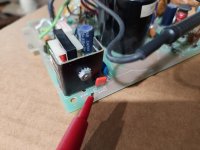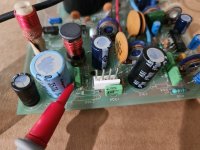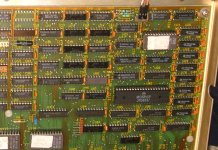Ah, ok. I didn't know if it being a "CRT Controller" changed what type of signal it might be generating. Good to know.
Back to the CRT driver board. I ordered the all of the electrolytic caps except for the big non-polar cap. In the mean time, I've been poking around the board with my multimeter. If you recall, something is pulling the +12vdc down to +8vdc when the board is connected, so I assume something is shorted. I only know how to do some rudimentary checks and even those, I'm not entirely sure of. I figured I'd find anything that looked like a short, report back here, and see what the experts say.
I found two possibilities. Both capacitors, neither electrolytic (I think). The first is a small cap next to what I believe is a transistor and a transformer. There are two capacitors of this type and value on the board. One reads open, which is what I expected, and the other reads shorted at 0.2 ohms.

The other possible problem cap also has others around it of the same type and value. They all test "open". The suspect cap reads 99.9 ohms. It wasn't enough to make it beep, but I still thought it was worth asking about. I don't know if either of these are expected due to other nearby components. I know that testing components in-circuit can be iffy, but I'm not going to remove each component to test it. I suppose I could remove those two and see if the values persist.

I think I'm going to start a new thread to post general information about the VP into, since this one is really a diagnostics thread that has gotten a little out of scope. I took some high resolution photos and think I have a better idea of what some of the various headers are for (not the 6 pin, sadly) as well as I've found some pictures of a different version of the board that has some differences from mine.



